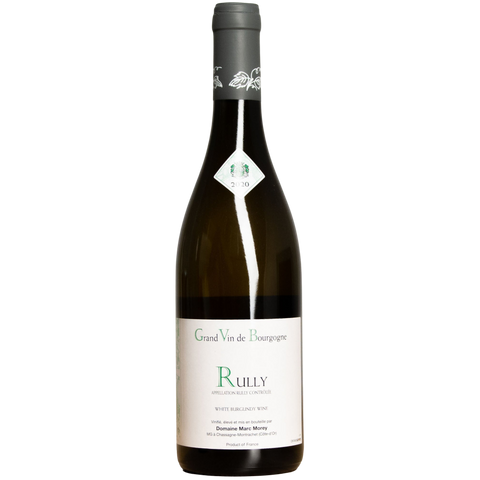
2023 Domaine Marc Morey & Fils Rully, Burgundy, France
Aromas of hazelnuts and white flowers. Medium bodied
with great balance and richness.
There are 23 units left in stock.
ABOUT THIS WINE
The village of Rully is located in the northern part of the Côte Chalonnaise in Burgundy. Temperature-controlled fermentation to start, with a transfer midway through to barrel (25% new oak). The wine rests on the lees for six months with occasional battonage and is then lightly filtered before bottling.
ABOUT THIS PRODUCER
With just under 400 inhabitants amongst the 44 families engaged in growing grapes and making wines, the village of Chassagne-Montrachet commands a stellar reputation in the production of some of the world’s finest Chardonnay and Pinot Noir. Since 1919, the Domaine Marc Morey has been working diligently to enhance that reputation over four generations, three of which continue their exploitation of some of the finest vineyards in Burgundy’s Cote d’Or. The Morey family name has joined the pantheon of well-known Chassagne producers, intertwined by familial relations with other notable estates named Coffinet, Pillot, Colin, etc. Their wines are consistently reviewed amongst the finest of the region.
Today the estate is run by Sabine Mollard, granddaughter of Marc Morey, himself the son of Fernand Morey, who first bought vines in the village after returning from WWI. Marc expanded on Fernand’s initial land purchases and began to bottle the estate’s wine production in 1937 under the name Domaine Fernand Morey. Marc Morey and his daughter Marie-Josephe, with her husband Bernard Mollard, continued the augmentation of the domaine, creating the estate as Domaine Marc Morey, a Societe Civile d’Exploitation (or family corporation) in 1977. Today, Sabine Mollard oversees the vineyards and winemaking, and Domaine Marc Morey produces some 60,000 bottles from its 9.5 hectares of vineyards in Chassagne, Puligny, and St. Aubin.
In the vineyards, respect for the environment is paramount. The domaine follows the rigors of the lutte raisnonee, using natural and organic treatments timed with the aid of local agricultural authorities, and only when absolutely necessary to combat rot, mildew, or oidium. Vines are pruned quite severely and trained in Guyot simple for the Chardonnay and cordon de Royat for the Pinot Noir and Aligote, followed by a rigorous bud pruning (ebourgeonnage) just before flowering to limit yields and provide optimal spacing of the grape bunches on each vine. At veraison, when the grapes change color on their way to ripening, leaves are pulled from around the grape bunches to encourage air circulation and uniform maturity in the vines. While cover grasses and wild flowers are encouraged between the rows, regular ploughing and working the soils encourages active micro-flora in the vineyards.
Harvest is the busiest and most complex time of the year, with extraordinary planning needed to schedule the 30 vendangeurs into teams for picking the grapes at optimum ripeness and balance in the nearly 20 parcels of vines spread over three villages. Great care is taken to ensure bright, fine acidities to complement ripeness and sugars, and the date of harvest of each parcel is determined by tasting the grapes to ensure the maturity of the fruit, including the seeds within. The harvest is complicated by the administrative functions of registering, paying, feeding, and lodging the 30 pickers over the 5 or 6 day harvest period at the domaine.
Winemaking techniques are designed to preserve the freshness and liveliness of each vintage, as well as the distinctive character of each individual parcel’s terroir – that combination of minerality, richness, elegance, and finesse that makes a vineyard site a distinctive impression and unique wine. Sabine’s goal is to make wines that are expressive and open when young, but also possess the structure and balance for aging and complex development. The whites are pressed with pneumatic presses and settle in temperature-controlled stainless steel tanks to remove the gross lees. Alcoholic fermentation proceeds slowly at low temperatures using natural yeasts, and the must is transferred into 228 liter barriques. During the elevage of approximately 10 months for the whites in 25 to 30% new oak, the lees are stirred (batonnage) once a week between the alcoholic and malolactic fermentations to enrich the wines and enhance their distinctive terroir characteristics. The wines are tasted regularly to judge their evolution, and assembled and bottled before the next harvest.
The red grapes are picked and selected on a table de triage to eliminate any sub-standard fruit before going into vat for a pre-fermentation cold maceration for a few days, depending on the vintage. For the Chassagnes Rouges in good vintages, about one-third of the bunches go into the vats as whole clusters, adding structure and depth. The fermentations begin slowly and gain speed as the temperatures of the cuves rises. To extract color, depth, and appropriate tannins, the must is frequently pumped over the cap (remontage) with occasional pushing down of the cap (pigeage) as well. The full cuvaison lasts approximately 3 weeks, at fairly high temperatures of 30°to 33°C, before the juice descends into barrels in the cellar (like the whites, 25 to 30% new oak) for 10 to 12 months for malolactic fermentation and aging. Interestingly, the press juice is kept separate and only added back to the red cuvees for tannin and structure if needed. Sabine Mollard’s goal is to produce reds of elegance, but with the depth and power to age gracefully.
Domaine Marc Morey is one of the most reputable estates in the Cote de Beaune. The wines are sold today by 18 importers in 14 countries worldwide, with a small amount reserved for the finest local restaurants and clients particulieres from across Europe who visit the domaine on a regular basis. Renowned for their finesse, freshness, minerality, and opulence, they truly reflect the best of Burgundy.
Details:
| Grape(s) | Chardonnay |
| Farming | Organic |
